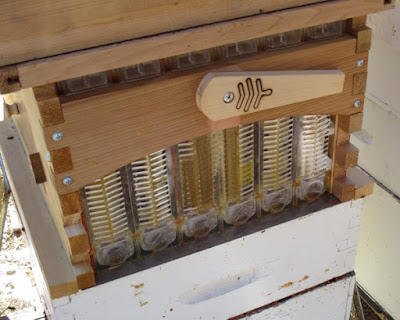 |
| Frame filled with honey and sealed with wax |
A few weeks ago, I went to Doug and Sheila's house to watch the honey extraction process. Doug is a hobby bee-keeper with a few hives.
 |
| super with frames filled with honey |
Before I arrived, Doug had removed a super from one of his hives. The super holds eight frames that the bees fill with honeycombs and then with honey. The tool on the top right is used to pry the frames out of the super.
 |
Doug uses a heated knife to trim the wax off of the
honey-filled frame |
As shown in the photo at the top of this post, the frames are sealed with a layer of wax that needs to be trimmed before the honey can be extracted. Doug has a heated knife that he uses to slice the wax off of the frame. The wax is saved and given to a local individual who uses it to make other products.
 |
| trimmed frames are placed in a spinner. |
 |
As Doug turns the handle on the spinner, the centrifugal force pulls the honey
from the frame. A drain at the bottom of the spinner is opened, and the honey
is then filtered to remove any foreign matter. |
Doug said that commercial bee-keepers have large electric spinners that spin numerous frames at one time.
 |
| Pure golden honey |
The honey from the Wind River Valley is a light, golden color with a mild flavor.
 |
| Obviously, I wasn't the only one observing the extraction process |
We ventured out to Doug's Bee-yard, too. . .
 |
| The hives were active and humming |
 |
| Bee-yard |
Doug explained that the queen is located in the bottom box of each hive. The boxes on top (supers) contain the honey that each hive is making and storing. See the short hive right of center with the different shaped top? It is a new design that Doug is trying.
Want a closer look?
We walked behind the hives, and Doug removed the back panel to check the progress of the hive. From the short time he's had this particular hive, Doug said he was not impressed with the amount of honey inside. The new feature on this hive is that the honey can be extracted directly without spinning.
Seeing the extraction process again was fascinating. Thank you Doug for allowing me to watch you extract the honey and for allowing me to take photos of the process for this post. It was a "sweet" afternoon.
Yes, I came home with some fresh honey, and it is delicious!












Bees are fascinating. In time, we may have hives of our own.
ReplyDeleteAre you sure that little bee wasn't saying, "hey! That's MY honey!" LOL
ReplyDeleteI love our local honey. I always feel like I'm helping the bees by buying LOCAL! LOL
Oh, I love this! Brings back memories of our next door neighbor when I was a kid. He raised bees and many times I got to chew on the waxy honeycomb. SO GOOD!
ReplyDeleteThat would be fun to see! Good to see working hives:)
ReplyDeleteMy throat could use some honey right now. I have seen the cool new extraction process on line. Ingenious
ReplyDeleteOh my, that was fascinating!! Thanks for sharing.
ReplyDeleteVery interesting post! I guess I just never thought about how the honey got into that cute little bottle, and we go through a lot of them. I remember my mom telling me about chewing on honeycomb wax when she was a little girl. It was something she fondly remembered.
ReplyDeleteWhere we lived for 30 years (prior to our current town) there was a large commercial honey producer. So I've seen the large version, but seeing the one-man version was so interesting. When we still lived on the farm, we kept hives for that producer and were paid in honey every year - 1 gallon or 2 depending on how many hives they placed.
ReplyDeleteFascinating post!
ReplyDeleteThis is an awesome post Nancy! I've always wondered how it worked.
ReplyDeleteHow amazing.... I bet that honey is good:)
ReplyDeleteSo interesting. I had no idea how they got the honey out of the honeycombs. Looks pretty tasty!!
ReplyDeleteI am fascinated by this process and beekeeping in general but I am far too much of a wimp to venture any closer than my computer screen. :) Bees are such amazing creatures.
ReplyDelete